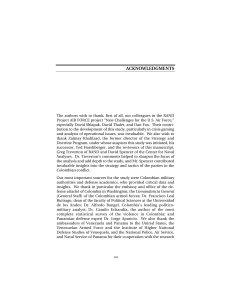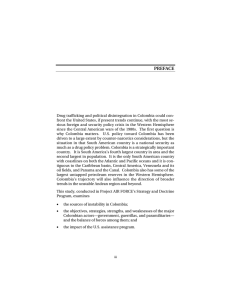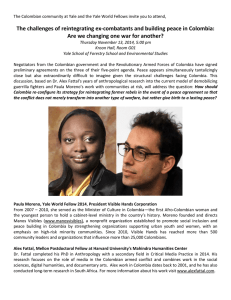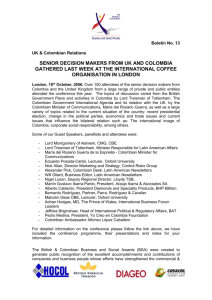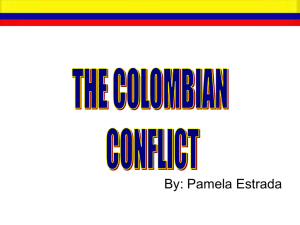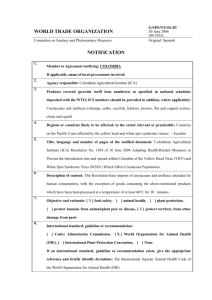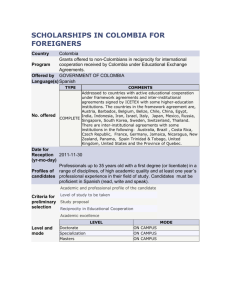COLOMBIAN GOVERNMENT STRATEGY PLAN COLOMBIA
advertisement
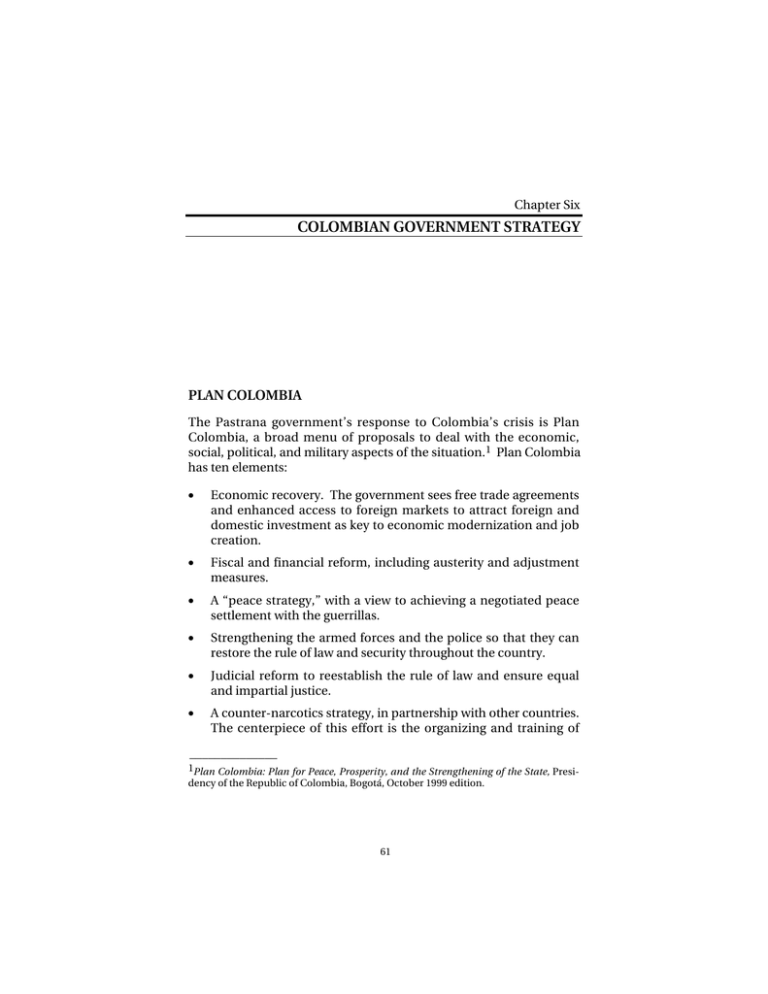
Chapter Six COLOMBIAN GOVERNMENT STRATEGY PLAN COLOMBIA The Pastrana government’s response to Colombia’s crisis is Plan Colombia, a broad menu of proposals to deal with the economic, social, political, and military aspects of the situation.1 Plan Colombia has ten elements: • Economic recovery. The government sees free trade agreements and enhanced access to foreign markets to attract foreign and domestic investment as key to economic modernization and job creation. • Fiscal and financial reform, including austerity and adjustment measures. • A “peace strategy,” with a view to achieving a negotiated peace settlement with the guerrillas. • Strengthening the armed forces and the police so that they can restore the rule of law and security throughout the country. • Judicial reform to reestablish the rule of law and ensure equal and impartial justice. • A counter-narcotics strategy, in partnership with other countries. The centerpiece of this effort is the organizing and training of ______________ 1Plan Colombia: Plan for Peace, Prosperity, and the Strengthening of the State, Presidency of the Republic of Colombia, Bogotá, October 1999 edition. 61 62 Colombian Labyrinth new counter-narcotics battalions to be deployed to the cocagrowing department of Putumayo (the “Drive to the South”)2; the battalions’ mission will be to secure the area while coca eradication takes place. • Agricultural development and other economic activities to provide legal alternatives for coca farmers and coca plantation laborers. • Popular mobilization to develop more accountability in local government, community involvement in anticorruption efforts, and pressure on the illegal armed groups to end kidnappings, violence, and the internal displacement of individuals and communities. • Social programs, for health, education, and alleviation of poverty. • Mobilization of the international community to participate in the Plan. To underwrite the cost of Plan Colombia, the Pastrana government undertook to provide $4 billion in national funds, while seeking $3.5 billion in foreign assistance, largely from the United States, the European Union, Japan, Canada, and international financial institutions. Consistent with the U.S. policy focus on the drug problem in Colombia, 74 percent of U.S. assistance to Plan Colombia was earmarked to support counter-narcotics.3 The Europeans, for their own part, prefer to channel their assistance to nonmilitary programs. The U.S. Congress approved in July 2000 an emergency supplemental assistance request for fiscal years 2000–2001 of $1.32 billion, of which $862.3 million was allocated to Colombia and the balance to neighboring countries (primarily Peru, Bolivia, and Ecuador) and to U.S. agencies’ Andean region antidrug operations. Of the $862.3 million allocated to Colombia, $521.2 million is new assistance to the Colombian armed forces and $123.1 million is assistance to the police, with the rest ($218 million) going to alternative eco______________ 2Colombia, Republic of. See also p. 64 ff. 3David Spencer and Heather Noss, p. 12. Colombian Government Strategy 63 nomic development, aid to displaced persons, judicial reform, law enforcement, and promotion of human rights.4 The bulk of the military assistance will support the Colombian armed forces’ three counter-narcotics battalions, which are to receive 16 UH-60 Black Hawk and 30 UH-1H Huey transport helicopters. Police assistance goes to a variety of items, the largest of which is a grant of two Black Hawk and 12 Huey helicopters. The package includes $68.5 million for alternative economic development and crop substitution, including $10 million to assist farmers displaced by the anticipated coca eradication operations in southern Colombia. Some $51 million is provided to improve human rights protections, including the establishment of joint human rights units made up of prosecutors and judicial police, witness and judicial protection, and assistance to nongovernmental organizations and the UN High Commissioner for Human Rights’ Bogotá field office. The U.S. package comes with a number of conditions, including a requirement for certification regarding trials in civilian courts of military officers facing credible allegations of gross human rights violations, military cooperation with civilian investigators, vigorous prosecution in civilian courts of paramilitaries and military officers who aid or abet them, development of a Judge Advocate General corps in field units to investigate misconduct by military personnel, and development of a strategy to eliminate all coca and poppy production by 2005. There are also reporting requirements and a cap on U.S. military personnel or contractors in the country at any one time.5 Members of the counter-narcotics units funded by U.S. assistance are individually screened for histories of human rights abuses. There is a question of the practical limitations on the Colombian government’s ability to prevent human rights violations in the context of an armed insurgency. The experience of other countries engaged in similar conflicts, including that of the United States in Vietnam, suggests that, even with disciplined troops, the chain of command will break down at times under the stress of armed conflict. That said, the Colombian government has made an effort to penalize ______________ 4For a description of the U.S. package, see Center for International Policy, “The Content of the Colombia Aid Package,” www.ciponline.org/colombia/aid/aidsumm.htm. 5Ibid. 64 Colombian Labyrinth human rights violations by members of the armed and security forces. The investigation and prosecution of crimes by military personnel fall under the supervision of the Procurator General and is independent of the military chain of command. From 1997 to 1999, 477 members of the military and the police were tried and found guilty of human rights violations.6 While Plan Colombia was presented in the United States as a key component of a counter-narcotics strategy, it was presented in Europe as a means of furthering the peace negotiations and economic reconstruction. 7 Participants at a Plan Colombia donors’ conference in Madrid in July 2000 agreed to provide an additional $619 million, mostly for social development projects. Spain was the largest donor, with a $100 million pledge. Japan and Norway pledged $70 million and $20 million, respectively. The rest of the funds were pledged by international financial institutions. 8 At a follow-up meeting in Bogotá in October 2000, representatives of the European Union agreed to contribute a total of $332 million (including the Spanish contribution) toward social and institutional development. 9 COUNTER-NARCOTICS STRATEGY The Colombian government’s counter-narcotics strategy combines ongoing efforts to interdict the movement of illegal drugs and precursor chemicals, coca and poppy eradication, and destruction of drug-processing facilities, with a plan to retake control of the drugproducing areas. The first phase of the plan is to take control of the FARC-controlled coca-growing areas in the department of Putumayo in southern Colombia. Putumayo and the neighboring department of Caquetá account for over one half of Colombia’s coca acreage.10 ______________ 6República de Colombia, La fuerza pública y los derechos humanos en Colombia, pp. 24–25. 7Libardo González, “El Plan Colombia: una paz armada,” Colombia Thema, No. 7, March–May 2000, http://www.colombia-thema.org. 8“La diplomacia saca la cara,” El Tiempo, Bogotá, August 3, 2000. 9“Otros US$144 millones de Europa a Plan Colombia,” El Tiempo, October 25, 2000. 10 Putumayo accounts for 35,100 hectares of coca fields, and Caquetá for 28,000 hectares, out of a nationwide total of 122,500 hectares, according to figures provided in a Colombian armed forces briefing, April 2000. More recent estimates are higher. Colombian Government Strategy 65 In the second phase, counter-narcotics operations would extend to the coca-growing regions in southeastern and central Colombia, and finally, to the whole country. As noted above, the bulk of the U.S. assistance package is designed to help the Colombian government implement this “Southern strategy.” Key priorities, as noted above, will be to train and equip the new counter-narcotics battalions. U.S. assistance also includes a program to improve the Colombian navy’s control of traffic on the country’s 18,000 kilometers of navigable rivers. A riverine brigade, with five battalions throughout the country, was established at Puerto Leguízamo, Putumayo, in August 1999. U.S. aid will also provide improved radar, airfields, and intelligence collection capabilities. Although U.S. assistance is provided for counter-narcotics purposes only, there is a clear linkage between the Colombian government’s counter-narcotics and counter-insurgency strategies. The Colombian government believes that, by striking at the drug trade, it also strikes at the economic center of gravity of the guerrillas. That is, by destroying the coca and poppy fields, drug-production facilities, and transportation networks, the government can also degrade the guerrillas’ ability to carry on the war.11 Whether this is an accurate assessment remains to be seen. According to some Colombian analysts, the center of gravity of the guerrillas is not their links to the drug trade but their political control of small towns and rural areas.12 Nevertheless, assuming that the government’s strategy of reducing the cultivation, processing, and distribution of narcotics is correct and that the new counter-narcotics battalions can successfully execute it, there may still be a time lag between the execution of the strategy and its impact on FARC resources and capabilities. According to U.S. officials, the first Black Hawk helicopter may not arrive in Colombia until October 2002.13 This period _____________________________________________________________ According to Colombian officials, at the beginning of 2001 there were at least 138,000 acres (55,890 hectares) of coca fields in Putumayo. “Plan Colombia: Herbicide Sprayings Killing Food Crops,” AP, January 23, 2001. 11Conversation with Colombian armed forces Commander General Tapias, Bogotá, April 2000. 12Discussion with Alfredo Rangel. 13Statement of Jess T. Ford, Director, International Affairs and Trade, U.S. General Accounting Office, before the U.S. House of Representatives, Subcommittee on Criminal 66 Colombian Labyrinth before the arrival of the U.S. military equipment may be the point of maximum danger for the Colombian government. There is a broadly shared assumption in Colombia that the FARC will escalate its military attacks once the government’s new counternarcotics battalions begin to operate in southern Colombia, bringing about a conflation of the war on drugs and the political war. This could bring into relief the contradictions between the government’s counter-narcotics and social and political objectives. According to the governor of Putumayo, about 135,000 of the department’s 314,000 inhabitants depend directly on the coca crop for their livelihood.14 Intensified coca eradication would probably be resisted by the local population, which would generate a serious social conflict, further delegitimize the Colombian government among the populace, and strengthen support for the FARC. There is already a great deal of criticism in Colombia of the government’s policy of aerial spraying of coca and poppy fields. Critics note that the spraying has not prevented the tripling of the area under coca cultivation since Pastrana’s inauguration, and that the spraying simply destroys the means of livelihood of subsistence farmers and displaces the crops deeper into the jungle.15 The coca producers have also adapted by developing new varieties of the coca plant, such as the Tingo María, which produces three times as much coca as the traditional varieties. 16 The Colombian military is very much aware of the economic, social, and political consequences of counternarcotics operations. In a discussion in Bogotá, General Tapias explained the need for spraying—given the large extension of the areas under cultivation and the impracticality of other eradication methods—but he also stressed that eradication alone would not work. It _____________________________________________________________ Justice, Drug Policy, and Human Resources, Committee on Government Reform, October 12, 2000. 14 Interview with Jorge Devia Murcia, governor of Putumayo, in Colombia Update, published by Colombia Human Rights Committee of Washington, D.C., Vol. 12, No. 1, Summer/Fall 2000, p. 7. 15Discussion with Horacio Serpa, former Colombian minister of interior, Washington, D.C., July 2000. 16Alfredo Molano, “Conflict, Peace, and International Intervention,” Colombia U pdate, Vol. 12, No. 1, Summer/Fall 2000, p. 5. Colombian Government Strategy 67 would have to be accompanied by an effective economic development and employment-generation policy.17 ROLE OF THE UNITED STATES For the Colombian government, the United States is the deus ex machina that would rescue it from its current predicament. The Pastrana government receives credit, even from political opponents, for having restored the cooperative relationship with the United States that had been badly frayed during the Samper presidency. At the same time, there has been criticism that the Colombian government strategy is driven by political constraints in U.S. policy that can justify aid to Colombia only in terms of counter-narcotics assistance. 18 This view is given further credence by the statement of a senior U.S. foreign policymaker at a U.S. Army War College Conference that the emphasis on counter-narcotics assistance represented a consensus within the U.S. government that could be placed at risk if the United States were to attempt to assume a counter-insurgency role.19 There has also been criticism of U.S. military support for the counter-narcotics aspect of Plan Colombia from some Colombians and Europeans on the grounds that it represents intensified militarization of the response to the drug problem and that it could undermine democracy and contribute to human rights abuses. Officials in Washington insist that they have little choice but to emphasize support for the Colombian military, given that the FARC and other illegal armed groups are involved in the drug trade. 20 ______________ 17Discussion with General Tapias. 18Discussion with Alfredo Rangel, Bogotá, Colombia, April 13, 2000. Colombian political scientist Francisco Leal Buitrago noted in a conversation with Dr. Rabasa that the first detailed draft of Plan Colombia was published, in English, right after U.S. Under Secretary of State Pickering’s visit to Bogotá. 19Richard Downes, “Landpower and Ambiguous Warfare: The Challenge of Colombia in the 21st Century,” U.S. Army War College, Strategic Studies Institute (SSI) Conference Report, March 10, 1999, p. 13. 20 Discussion with Bruce Bagley, University of Miami, February 11, 2000. See also Zirnite, p. 166. 68 Colombian Labyrinth The FARC clearly believes that U.S. counter-narcotics assistance is directed against it, that it is, in effect, disguised counter-insurgency assistance, and that if they, the guerrillas, were to gain the upper hand, the United States would intervene on the side of the Bogotá government. Therefore, in its public posture, the FARC has stressed the threat that U.S. military assistance to Colombia poses to the peace process, a theme that plays well with some domestic and international audiences. The FARC professes to be opposed in principle to the narcotics trade, while criticizing the methods employed by the Colombian government—aerial spraying in particular. It has also sought to forestall direct U.S. intervention by drawing parallels between Colombia and Vietnam. Colombia’s neighbors are caught between a hammer and an anvil. On the one hand, with the possible exception of Venezuela, they formally support Plan Colombia. As the Ecuadorean Foreign Minister stated in Washington in October 2000, Colombia’s neighbors understand that the Colombian drug-producing and drug-trafficking complex is a cancer that needs to be extirpated. On the other hand, they fear that if the attack on drugs in Putumayo is successful, it might succeed in driving the drug problem across the border into their countries (see Chapter Nine). The core question for policymakers is: Will the U.S. assistance program as currently structured help the Colombian government reduce the threats of drugs and insurgency and restore its authority? This question can be subdivided into a number of issues. Strategic and operational issues are discussed in Chapter Ten. Two questions are discussed here: Is the level of U.S. assistance adequate? Can it be sustained? The view of many Colombian and U.S. experts is that the current level of U.S. assistance is insufficient to alter the balance of forces. Participants at a symposium sponsored by the Center for Naval Analyses (CNA) in October 2000 noted that the Colombian fleet of helicopters and fixed-wing aircraft is roughly the same size as that of the Salvadoran military at the peak of the war in El Salvador, which was fought on a territory one fiftieth the size of Colombia.21 A U.S. General Accounting Office (GAO) official stated in congressional testimony in October 2000 that U.S. officials believe that substantial ______________ 21Spencer and Noss, p. 8. Colombian Government Strategy 69 funding for Plan Colombia beyond that planned for fiscal years 2000– 2001 would be needed. In addition to the issue of overall assistance levels, the GAO has questioned whether the United States has provided adequate spare parts and funding to maintain and operate helicopters provided under the counter-narcotics assistance program.22 Will the United States provide sustained, high levels of assistance? The United States has committed to underwrite support for the counter-narcotics efforts in Colombia for the next two years (fiscal years 2000–2001). The Colombian government’s stated goal is to eliminate all coca and poppy production by 2005. From December 2000 to February 2001, U.S.-backed antidrug drives resulted in the destruction of more than 29,000 hectares of coca fields (enough to produce 200–250 tons of cocaine annually). However, there are serious questions as to whether this rate of coca eradication can be sustained. Many areas still to be targeted are harder to reach and under FARC control. 23 Indeed, most experts, including some U.S. officials, agree that the type of response that is currently being emphasized by Washington would require a sustained level of commitment over a long period of time. 24 Certainly, to expect Colombia to take up the slack should the level of U.S. assistance drop substantially after fiscal year 2001 is unrealistic, particularly given the country’s economic difficulties25 and the technical challenges of maintaining advanced military equipment. The implications of the U.S. assistance program for Colombia are that the United States, by taking the lead in mustering international support for Plan Colombia, has increased its political stake in Colombia. If the Pastrana administration falters, either in its counter-narcotics or counter-insurgency approach, the United States would be confronted with an unpalatable choice. It could escalate its commitment, to include perhaps an operational role for U.S. forces in Colombia, or scale it down, which could involve ______________ 22Statement of Jess T. Ford, fn 13. 23Financial Times, February 20, 2001. 24Bagley. See also “U.S. Officials Say Anti-Drug Plan for Colombia Will Take Time to Show Results,” CNN Interactive World Wide News, February 22, 2000; Ford testimony, fn 13. 25Shifter, “The United States and Colombia: Partners in Ambiguity,” p. 53. 70 Colombian Labyrinth some significant costs, including a serious loss of credibility and degradation of the U.S. ability to muster regional support for its counter-narcotics and political objectives. At the same time, Bogotá has essentially adopted a U.S. vision of the problem—which focuses on narcotics eradication—as the centerpiece of its strategy. As a result, it has gained access to substantial U.S. resources, but at the cost of a loss of flexibility to design and implement its own solutions.
